Harissa Roasted Cauliflower
This harissa roasted cauliflower is a versatile and indulgent meat-free meal. It features a fragrant harissa butter marinade and an Ottolenghi-style slow-roasting technique for a delightful veggie main or side.
This harissa roasted cauliflower is an indulgent meat-free showstopper, equally fitting for a special occasion or a cosy weeknight dinner.
I learned this butter-basting trick for roasting cauliflower from Ixta Belfrage and Yotam Ottolenghi’s “Cauliflower roasted in chilli butter” recipe in their iconic cookbook Flavour. And in true Ottolenghi fashion, this recipe treats cauliflower as the star. The sweet grilled onions, lots of browned harissa butter and a slow cooking process turn this roasted cauliflower into a ridiculously delicious, almost meaty, vegetable centrepiece.
Serve it as a vegetarian main meal with a side salad and crusty bread to mop up the buttery sauce. Or spoil your guests with a scrumptious side dish for a simple roasted fish or chicken main.
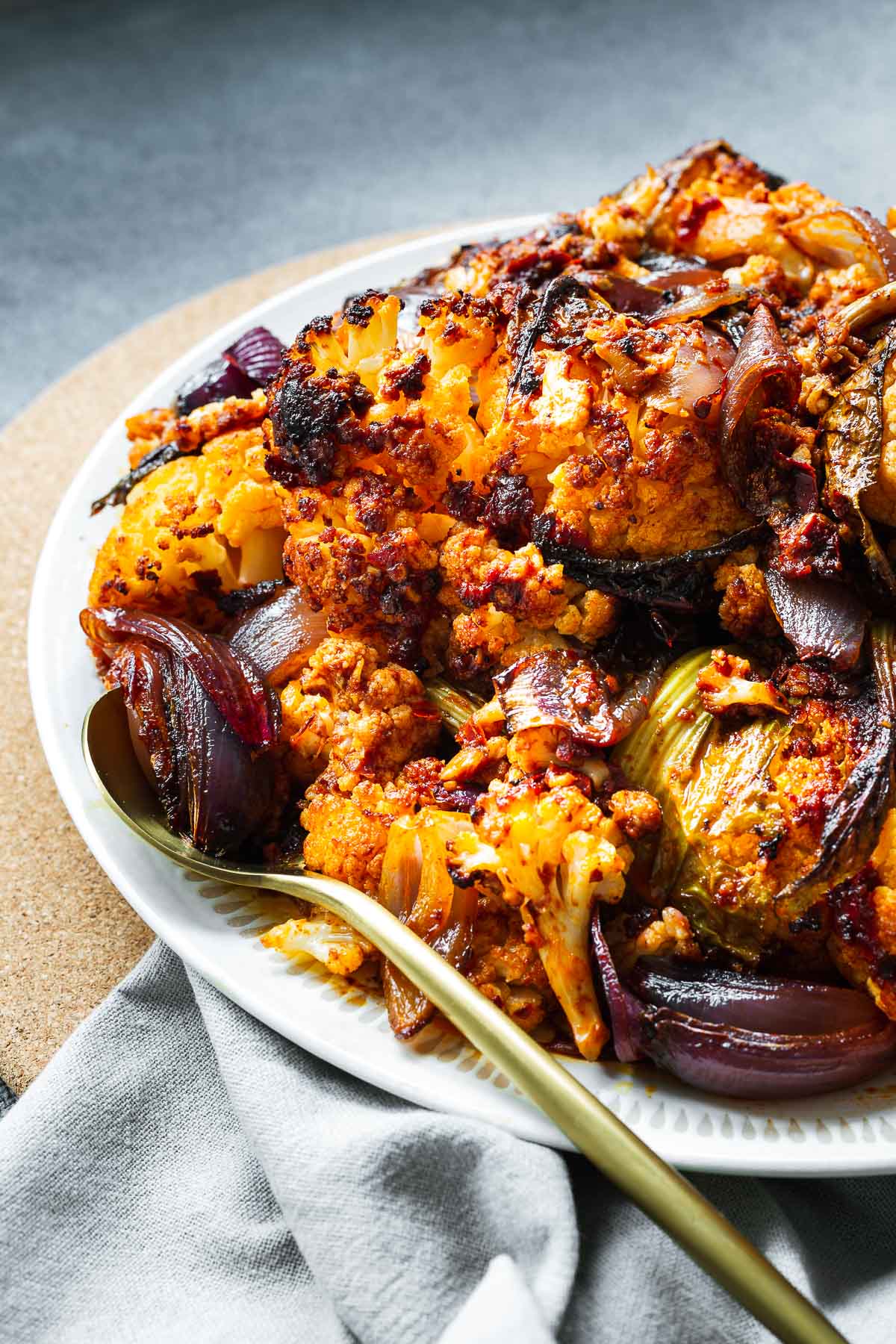
In this post
Ingredients and substitutes
This indulgent buttery roasted cauliflower with harissa recipe is not only utterly delicious but also super flexible. Substitute ingredients to fit your preference and your pantry.
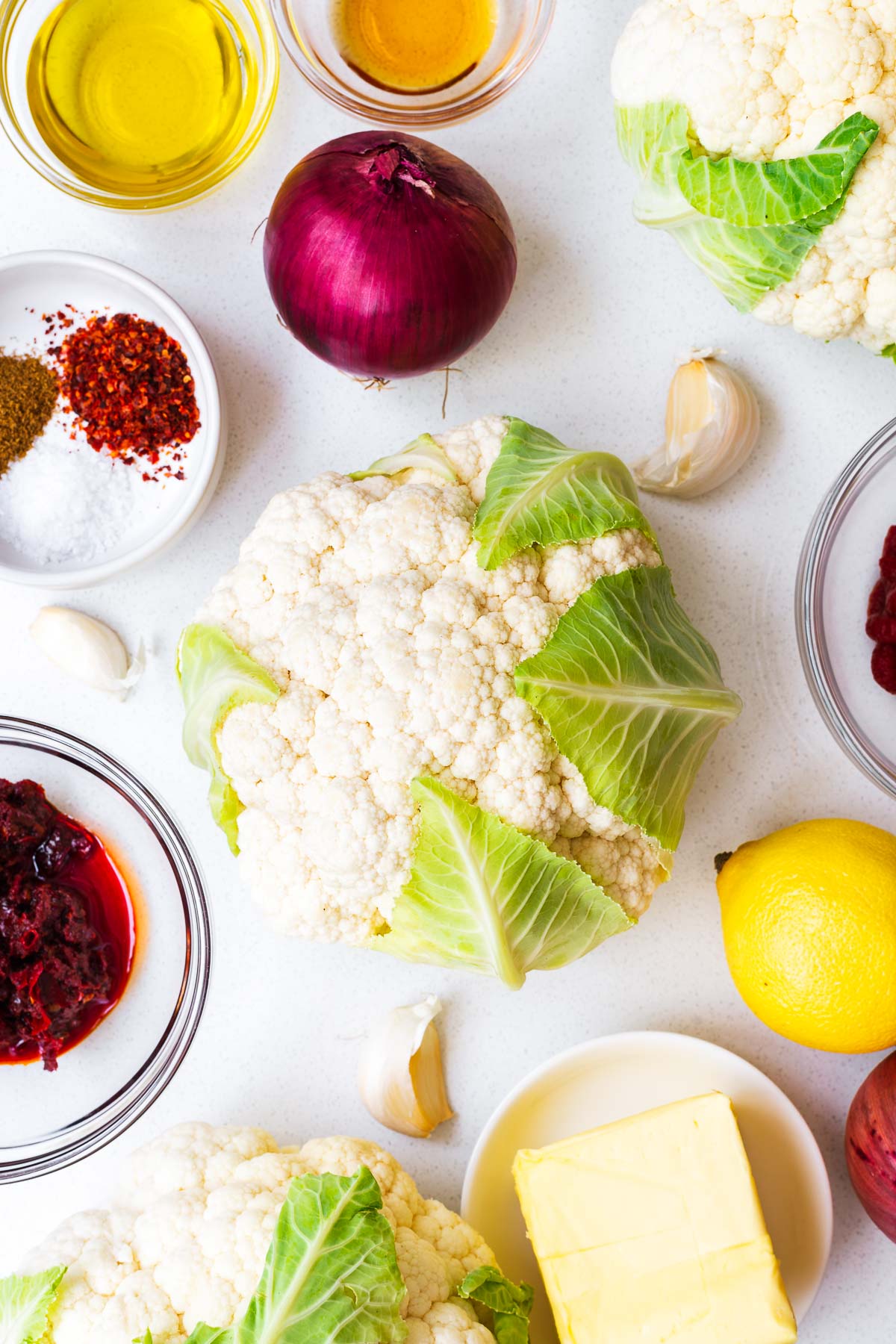
Veggies
- Cauliflower: You’ll need two very large whole cauliflowers or three medium-sized ones (large ones work best). Look for cauliflower with some of the outer leaves attached. And make sure your roasting tray has enough space to fit the cauliflower pieces in a single layer with space between them. To use cauliflower florets instead, increase the oven temperature and reduce the cooking time to avoid overcooking while allowing for ample browning of cauliflower florets.
- Onions: The roasted onions add sweetness to the dish. You can use red or white onions.
Harissa butter marinade
The harissa butter marinade adds a spicy and fragrant kick with caramelised brown butter vibes.
- Harissa paste: This North African red pepper paste is the key flavour of the marinade with its fragrant, spicy taste. If you can’t find harissa paste, you can make your own rose harissa paste from roasted bell peppers, or make quick and easy harissa from rehydrated chiles, or try a harissa paste substitute instead.
- Butter: I use unsalted butter in this recipe. But you can just as easily use salted butter. Simply adjust the amount of salt in the recipe to taste. And, for a vegan option, swap the butter for olive oil or try to use this vegan harissa dressing as a marinade instead.
- Tomato paste: If you don’t have tomato paste, substitute it with more harissa paste for a sweeter, spicier end result.
- Olive oil: Use good quality extra-virgin olive oil for added richness and flavour.
- Maple syrup: A touch of maple syrup boosts the natural sweetness and aids in caramelisation. If you prefer, you can omit it or substitute it with caster sugar. Or try it with hot honey for more heat.
- Garlic: Minced garlic adds savoury notes. If you don’t have fresh garlic, substitute it with two teaspoons of garlic powder.
- Cumin: Adds a warm and earthy flavour to the dish. But you can omit it if you don’t have any – we have enough bold flavours going on.
- Lemon zest and lemon wedges: The zest adds a bright and citrusy flavour to the harissa butter marinade. And, finishing the dish with a squeeze of fresh lemon juice cuts through the richness of the butter.
- Aleppo chilli flakes: Adds a subtle heat to the dish. If you don’t have Aleppo chilli flakes, you can substitute it with regular chilli flakes or a pinch of cayenne pepper (or try another Aleppo pepper substitute). Or omit it if the harissa is spicy enough for your taste.
- Salt: I use kosher salt in the harissa butter marinade. And using coarse sea salt when blanching the cauliflower ensures that it is seasoned throughout. You can also use any salt and adjust the seasoning to taste. Sprinkle the finished dish with Maldon salt flakes if you have some.
Optional add-ins
While this cauliflower roast holds its own as a meat-free main meal or side dish, you can still bulk it up to feed a crowd.
- Red chillies: Do as Yotam Ottolenghi does and add eight fresh red chillies. Cut a vertical slit into each chilli and add it to the roasting tray with the cauliflower and onions. It creates a super spicy cauliflower roast.
- Chickpeas: Cauliflower, chickpeas, and harissa are great friends. Turn this indulgent, buttery cauliflower into a more substantial meal with a can of drained chickpeas. Add the chickpeas for the second half of the cook.
- Red bell peppers: Core and devein two red bell peppers and slice them into thick strips. Add them to the baking sheet for the full roasting time.
If you use these optional add-ins, ensure your roasting tray is large enough to fit everything in an even layer. Or spread the cauliflower over two trays.
How to make harissa roasted cauliflower (step-by-step)
Slow-roasting this cauliflower allows it to get buttery and caramelised. And while it needs some time in the oven to achieve the best results, it’s a deceivingly simple recipe.
Have your buttery harissa cauliflower ready in six easy steps:
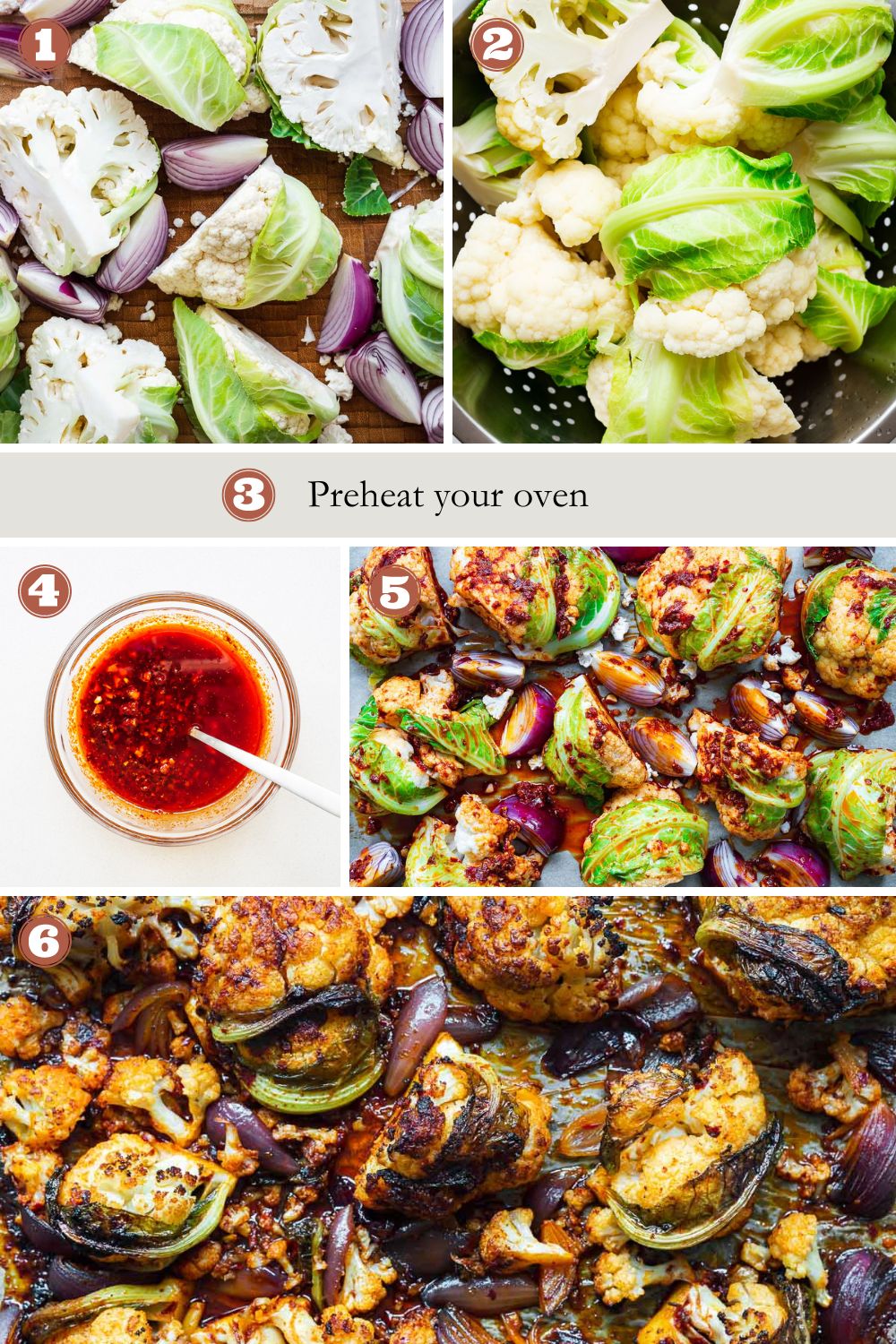
Step 1: Prepare the vegetables
Quarter cauliflowers lengthways, leaving the leaves on if available. Trim the leaves slightly to expose the cauliflower tops.
Cut each onion into six wedges.
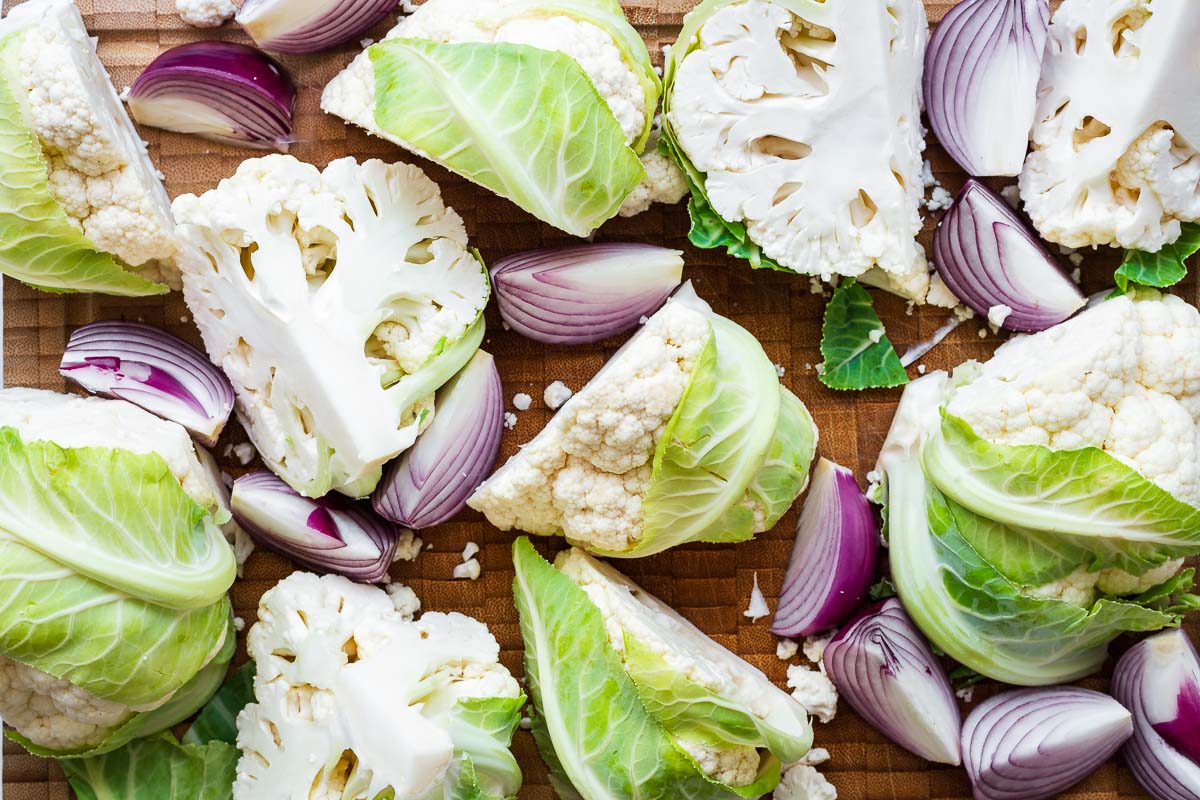
Step 2: Blanch the cauliflower
Fill a large pot with salted water and bring to a rolling boil. I use roughly one tablespoon for every quart (litre) of water.
Blanch the cauliflower quarters for 2 minutes. Keep them submerged by gently pressing down with a spatula or top the cauliflower with a smaller pot’s lid.
You may need to do this in two batches if your pot is not big enough to fit all the cauliflower.
Drain well in a colander.
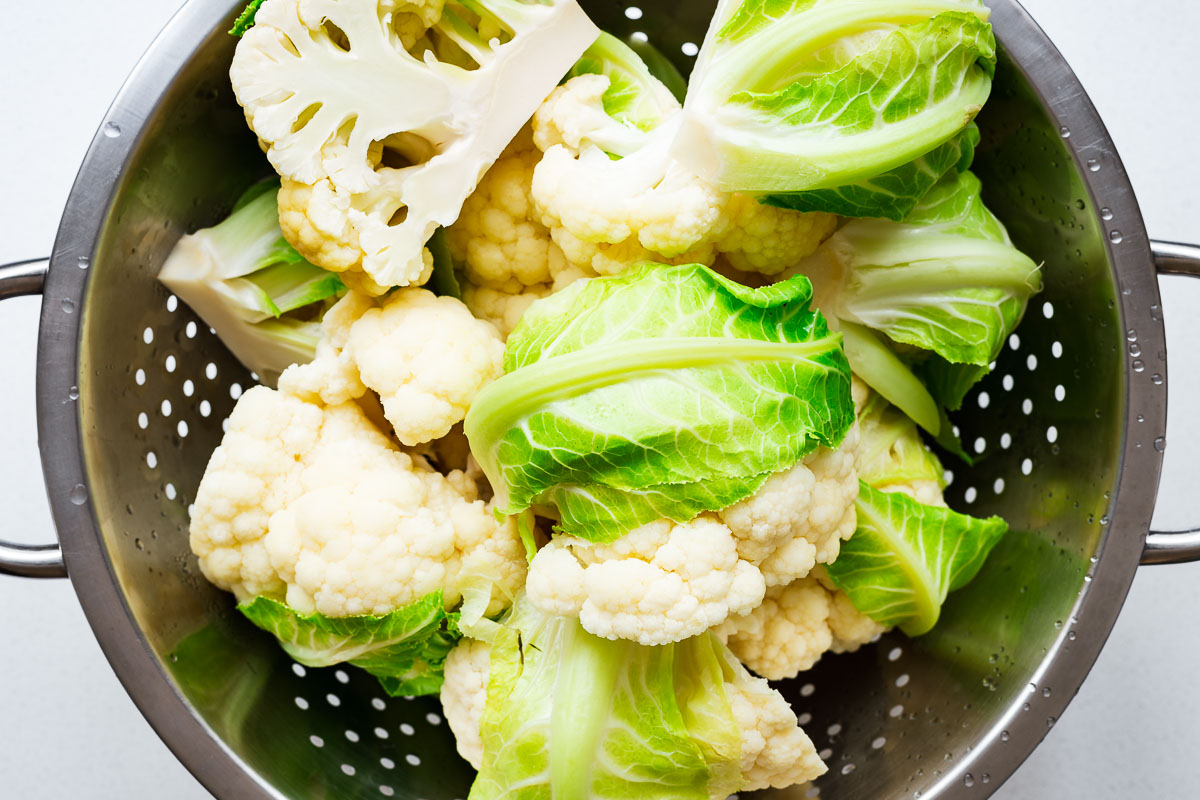
Step 3: Preheat the oven
Preheat a conventional oven to 400 °F (200 °C). This is roughly equal to 360 °F (180 °C) in a convection oven (fan oven).
A note on ovens: Ovens vary greatly in how they regulate oven temperature. I use a large conventional oven that performs differently from small convection ovens (fan ovens). This article (from the spruce eats) explains the difference well.
The rule of thumb is to reduce the oven temperature by 20 °C to convert the temperature for a conventional oven to a fan oven. It is not the same as reducing the temperature by 68 °F because the relationship between Celsius and Fahrenheit is not linear.
Get to know YOUR oven. And always check on your food to adjust the temperature accordingly.
Step 4: Make the harissa butter
Combine the melted unsalted butter, olive oil, harissa paste, tomato paste, maple syrup, minced garlic, ground cumin, lemon zest, Aleppo chilli flakes, and salt in a medium-sized mixing bowl.
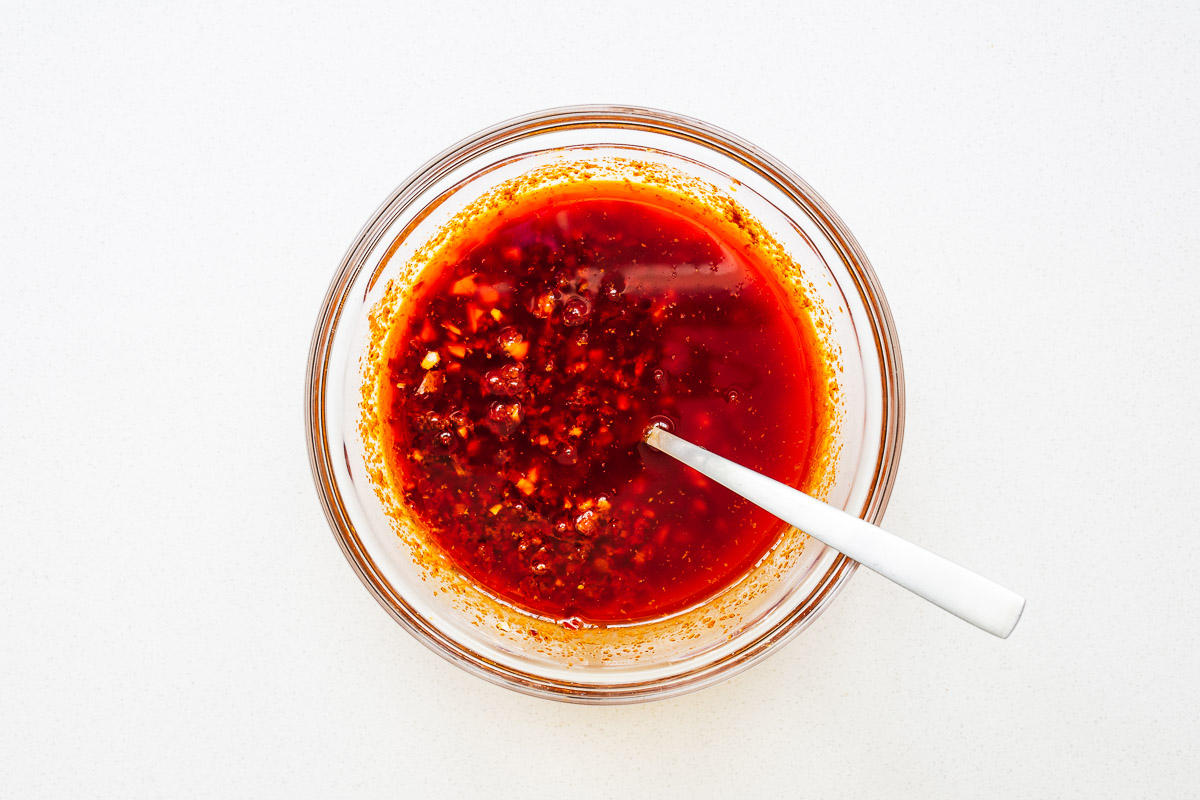
Step 5: Coat the vegetables
Coat each piece of cauliflower in the harissa butter marinade by swirling it in the mixing bowl and rubbing sauce into the crevices.
Arrange each cauliflower quarter with one cut side facing down on a parchment-lined baking sheet (with rim) in an evenly spaced single layer. Add the onion wedges between pieces of cauliflower.
Spoon any remaining harissa butter over the veggies.
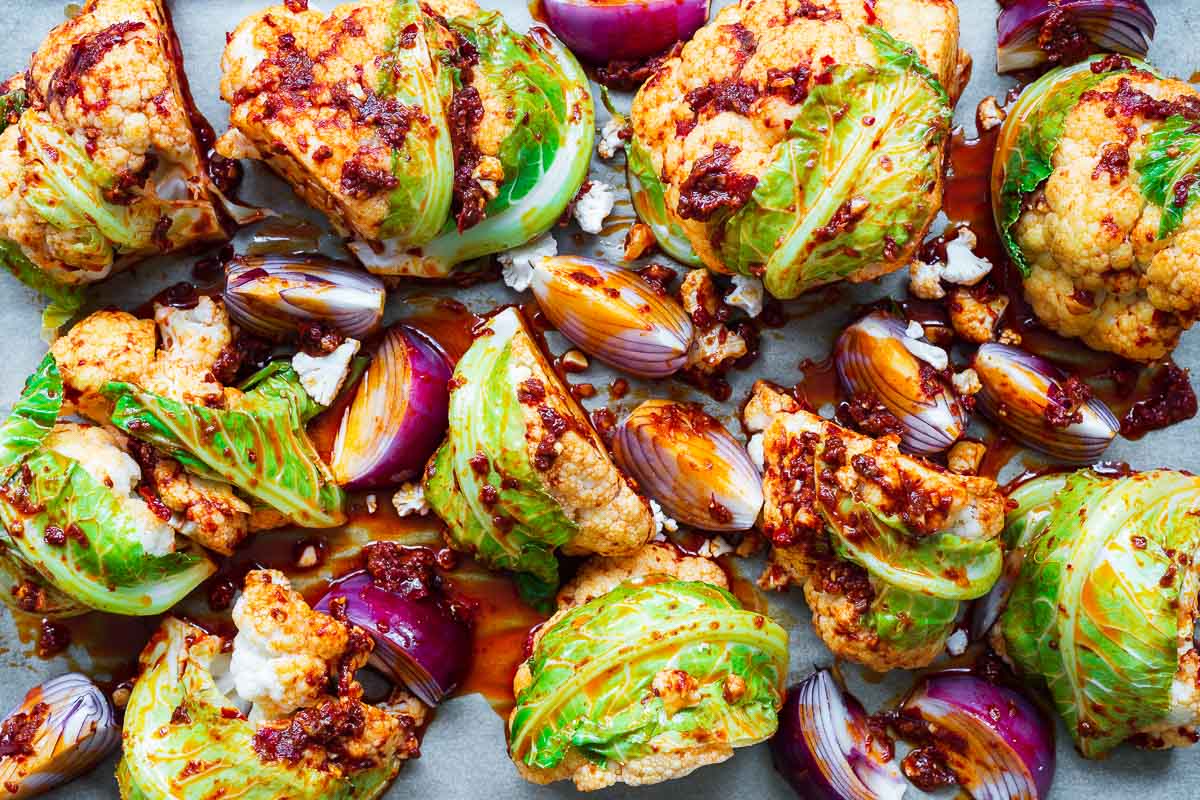
Step 6: Roast the cauliflower
Place the sheet pan in the centre of the oven and roast the cauliflower for 30 minutes. Baste the cauliflower with the melted harissa butter from the roasting sheet.
Reduce the oven temperature to 370°F / 190°C (340°F / 170°C in a convection oven) and continue roasting for another 30-40 minutes, basting twice, until the cauliflower browns and leaves crisp up.
Transfer the cauliflower and onions to a serving platter or serving bowl – don’t worry if the large wedges fall apart a bit. Spoon over any remaining harissa butter and browned bits from the baking tray.
Taste a small piece, and sprinkle with salt if needed (use Maldon salt flakes if you have any) and a generous grind of black pepper. Serve with lemon wedges on the side.
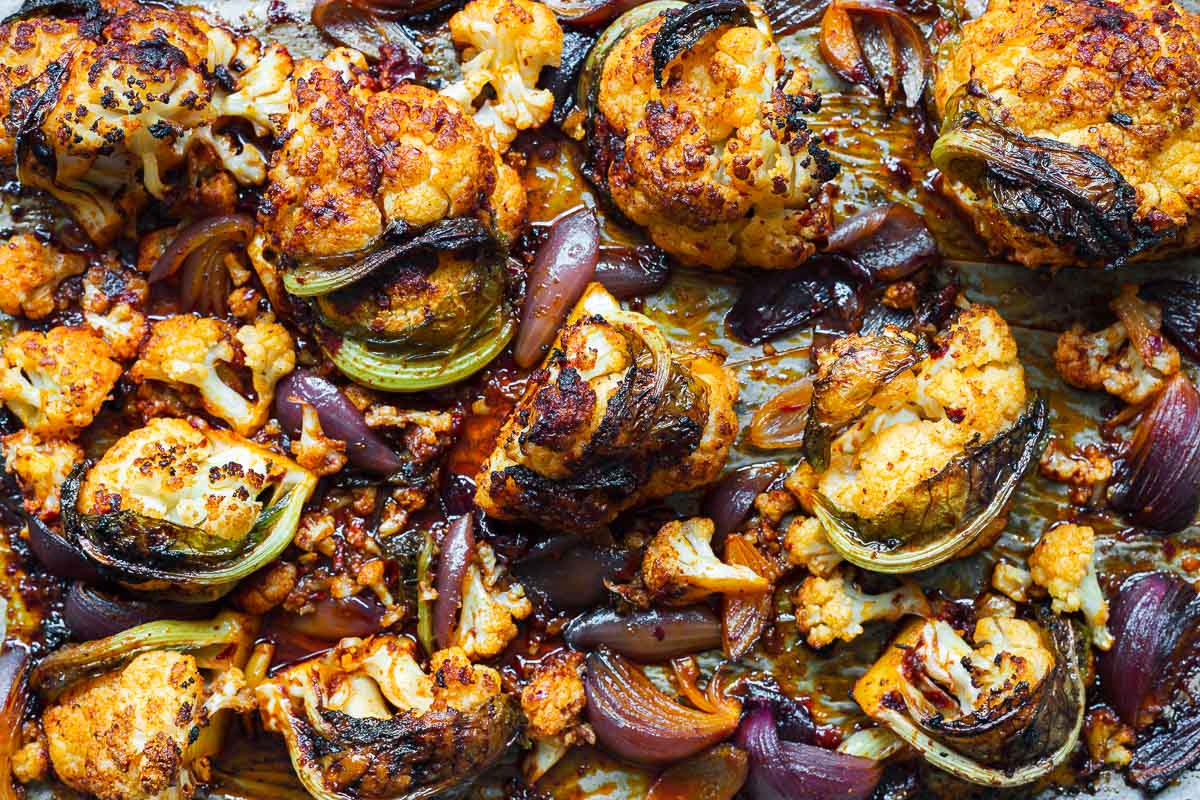
How to serve
This fragrant harissa roast cauliflower effortlessly transitions between an indulgent vegetarian main or a delightful side. With its enticing blend of spices and generous use of brown butter, this cauliflower dish won’t disappoint!
It is also naturally gluten-free. And if you would like to serve it as a vegan main, you can replace the melted butter with more olive oil.
As a vegetarian main
Serve harissa roasted cauliflower as the star of your meal, surrounded by a selection of vibrant and refreshing sides. Consider pairing it with a tangy citrus salad, an aromatic herbed couscous, labneh (strained yoghurt), or a refreshing Persian cucumber yoghurt sauce (mast-o khiar) to balance the robust flavours of the harissa and brown butter.
For a heartier option, place the harissa roast cauliflower on a bed of warm quinoa, lentils or crushed chickpeas. Drizzle it with lemon tahini sauce – the cauliflower-harissa-tahini combination is a classic. Sprinkle with toasted almonds or pine nuts for an extra layer of texture and nuttiness. And scatter roughly chopped fresh herbs.
As a side dish
Harissa roasted cauliflower is also an excellent side dish, complementing a variety of proteins. Serve it alongside grilled chicken or pan-seared fish. Or, for a meat-free alternative, try pairing the cauliflower with marinated tofu steaks or charred halloumi cheese.
As part of a mezze spread
I love to entertain with a generous veggie-forward mezze spread. And this harissa roasted cauliflower pairs perfectly with other Middle Eastern flavours such as crispy falafel, creamy hummus, bulgur wheat salad or Arabic chopped salad, and warm pita bread.
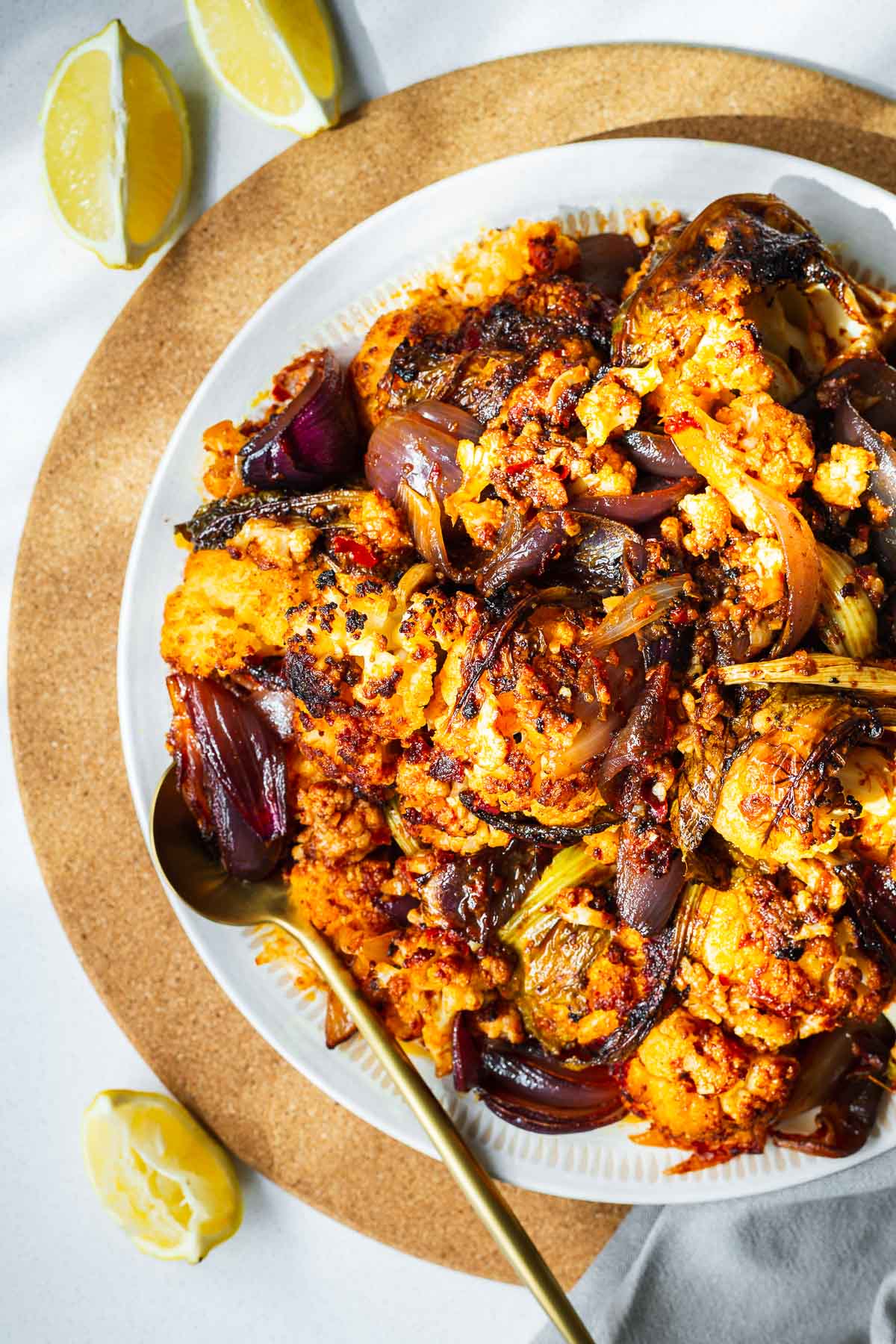
However you choose to serve your harissa roasted cauliflower, the key is to let the bold and indulgent flavours take centre stage. Don’t be afraid to get creative with your pairings and presentation, and allow this surprisingly indulgent veggie dish to shine.
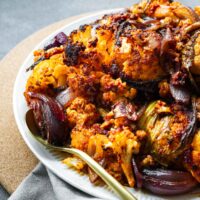
Equipment
- Baking sheet – It should be large enough to fit all the cauliflower with space between the wedges with a rim to contain the buttery sauce. I use a half-sheet pan that meassures 13” x 18” (33cm x 46cm).
Ingredients
- 4 pounds whole cauliflower heads (2 to 3), with leaves if possible
- 2 red onions, peeled, trimmed and cut into six wedges each
- salt, for blanching
Harissa butter marinade
- ½ cup unsalted butter (1 stick), melted
- 4 tablespoons olive oil
- 3 tablespoons harissa paste, or more to taste
- 3 tablespoons tomato paste
- 2 teaspoons maple syrup
- 3 garlic cloves, minced
- 1 teaspoon ground cumin
- 1 tablespoon lemon zest, from 1 whole lemon (reserve the lemon)
- 1 teaspoon Aleppo chilli flakes (optional)
- 1 teaspoon salt
To serve
- black pepper and salt flakes, to taste
- lemon wedges, from the reserved lemon
Instructions
- Cut the cauliflower into quarters (or in half if you have tiny cauliflowers). Leave any cauliflower leaves attached at the base. Just trim them back a touch so that the top of the cauliflower is exposed.
- Fill a large pot with well-salted water – I use a tablespoon of salt per quart (litre) of water. Place the pot over high heat and bring the water to a rolling boil. Blanch the cauliflower in the boiling water for 2 minutes. Press down on the cauliflower with a spatula to keep them submerged. You may need to blanch them in batches if all the cauliflower can't fit into the pot. Transfer to a colander and drain well.
- Preheat a conventional oven to 400 °F (or 360 °F for a convection oven).
- Mix all the ingredients for the harissa butter marinade in a medium-sized bowl. Rub each piece of cauliflower in harissa butter and place them on a large parchment-lined, rimmed baking sheet cut side down (so that the outer leaves are exposed). The baking sheet should be large enough that there is space between the cauliflower pieces. Distribute the onion wedges across the gaps, and spoon the remaining harissa marinade over the veggies.
- Roast for 30 minutes. Baste the cauliflower and onions with the harissa juices from the baking sheet. Then turn the heat down to 370 °F (340 °F in a convection oven) and continue to roast for another 30 to 40 minutes, basting twice, until the cauliflower is well-browned, the leaves are crispy, and the inside soft.
- Transfer everything to a serving platter. And drizzle with the remaining harissa butter and browned aromatics from the baking tray. Serve at once, with a generous grind of black pepper, salt (use Maldon flakes if you have them) and the lemon wedges alongside.
Notes
- Different brands of harissa will have different levels of spiciness. Have a taste and swap some tomato paste for more harissa if you want more heat. Try a harissa paste substitute if you don’t have harissa, or make your own rose harissa paste from roasted red bell peppers, or try easy harissa paste from dried chiles.
- If you made this harissa butter recipe, melt the harissa butter and whisk together with the olive oil, tomato paste, maple syrup, and chilli flakes. Add an extra ¾ teaspoon of salt, another minced clove of garlic, and another tablespoon of harissa paste.
- This recipe was tested in a conventional oven, though I suggest convection oven temperatures based on industry standards. Every oven is different, so use your senses to adjust your oven temperature accordingly. You want the cauliflower to be tender inside and well-browned on the outside. The size of your cauliflower chunks also impacts the cooking time.
Homemade harissa
- See how to make rose harissa paste (or normal harissa paste) from roasted red bell peppers.
- Or make an easy harissa paste using rehydrated dried chiles.
- You can also make harissa paste from harissa powder (+ how to make harissa powder).
- Or try one of the best harissa substitutes for an instant harissa paste alternative.
- Make a fragrant dry harissa powder – a homemade spice blend from toasted whole chiles and spices – to reconstitute into harissa paste in a moment.
My most popular recipes with harissa paste
If you like this lemon tahini sauce, you might also like these tahini dressings and sauces



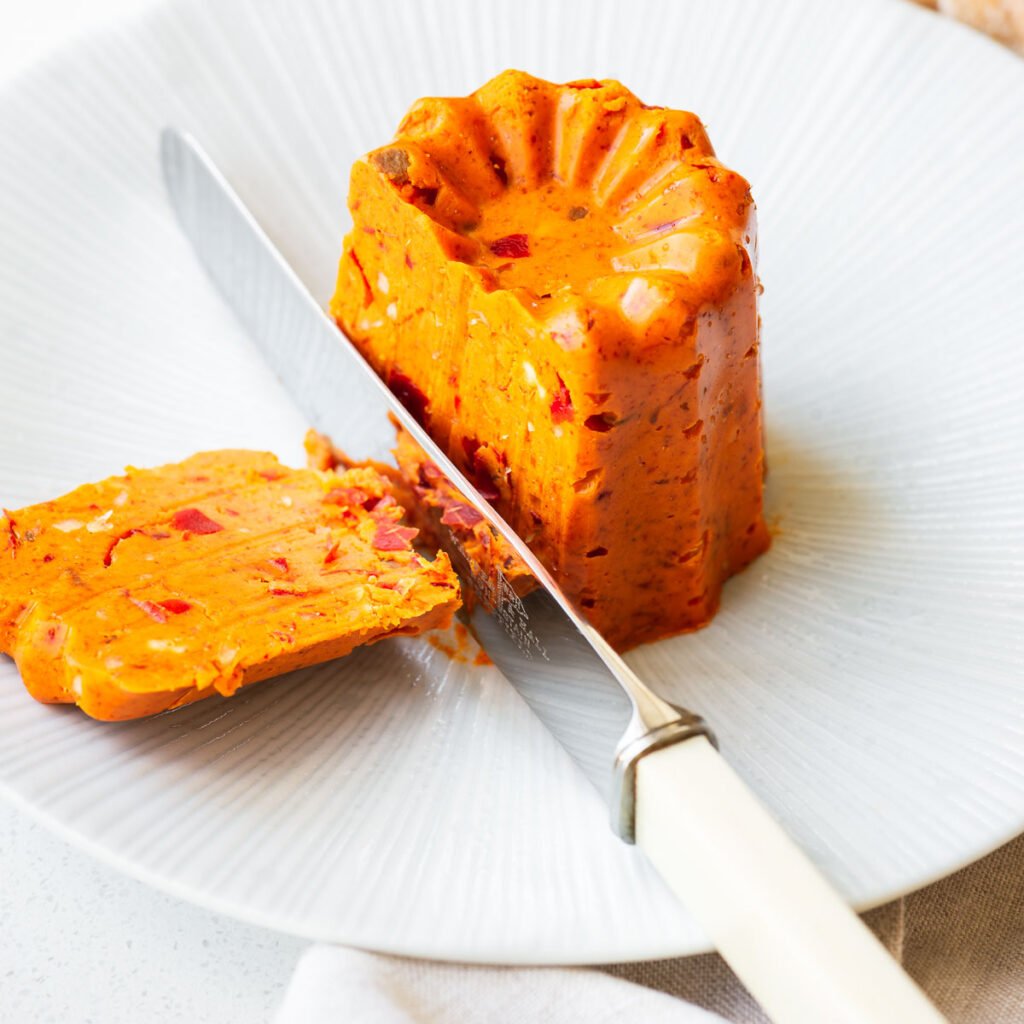

So good! We gobbled this up with sourdough bread. Yum!
So happy you loved it, Dawn! Sourdough bread is such a great way to enjoy harissa roasted cauliflower as a meal, the perfect combo. 😍
Woe! I cannot believe it is only vegetables! My 2-year-old daughter daughter, who hates veggies, kept asking for more, calling it vegetable meat. 😀
I just love this! You and your adorable daughter made my day. ❤️